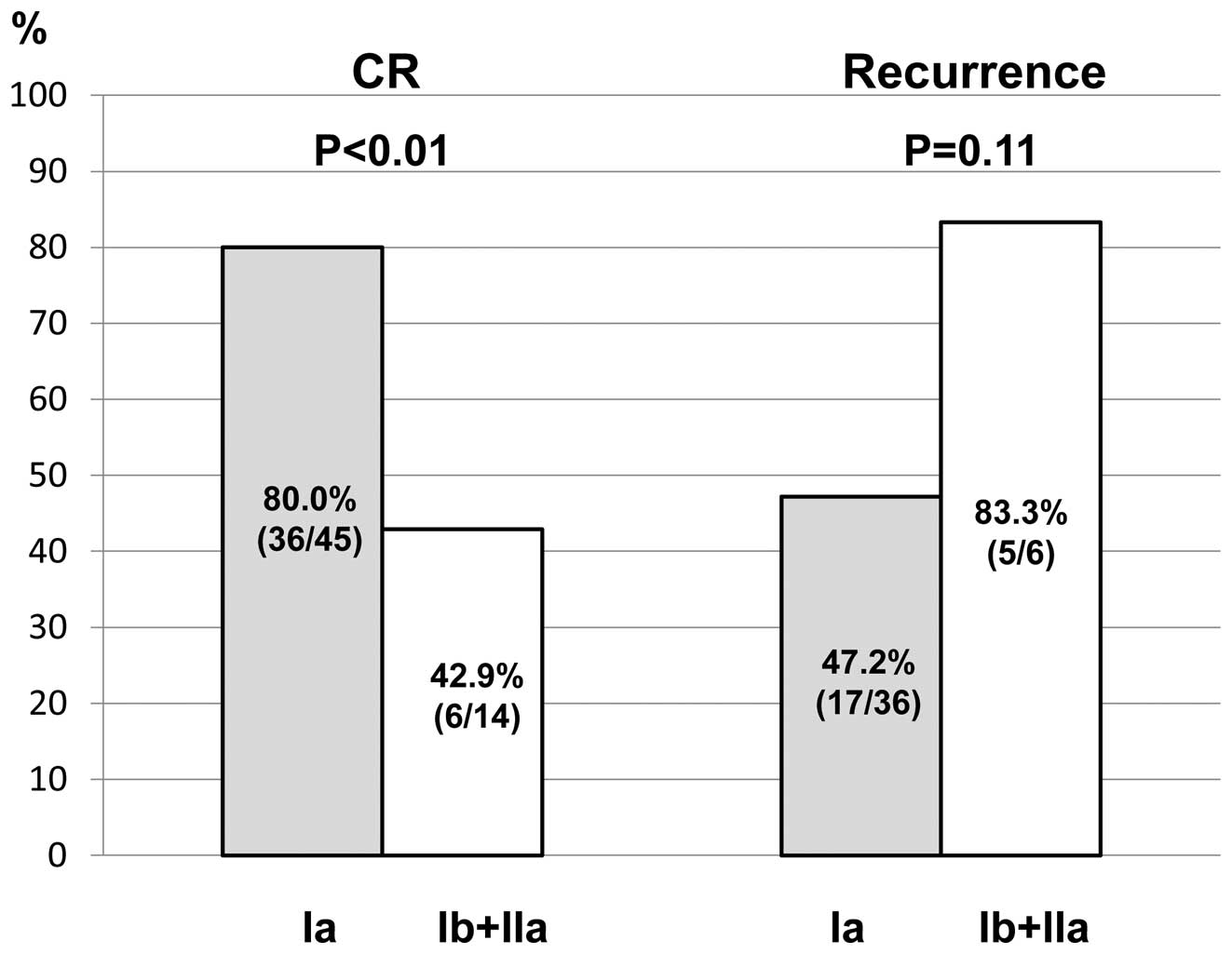|
1
|
Jemal A, Siegel R, Xu J and Ward E: Cancer
statistics. CA Cancer J Clin. 60:277–300. 2010.
|
|
2
|
Amant F, Moerman P, Neven P, Timmerman D,
Van Limbergen E and Vergote I: Endometrial cancer. Lancet.
366:491–505. 2005. View Article : Google Scholar : PubMed/NCBI
|
|
3
|
Parazzini F, La Vecchia C, Bocciolone L
and Franceschi S: The epidemiology of endometrial cancer. Gynecol
Oncol. 41:1–16. 1991. View Article : Google Scholar
|
|
4
|
Brinton LA, Berman ML, Mortel R, et al:
Reproductive, menstrual, and medical risk factors for endometrial
cancer: results from a case-control study. Am J Obstet Gynecol.
167:1317–1325. 1992. View Article : Google Scholar : PubMed/NCBI
|
|
5
|
Lurain JR: Uterine Cancer. Berek &
Novak’s Gynecology. Berek JS: 14th edition. Lippincott Williams
& Wilkins; Philadelphia: pp. 1343–1401. 2007
|
|
6
|
Crissman JD, Azoury RS, Barnes AE and
Schellhas HF: Endometrial carcinoma in women 40 years of age or
younger. Obstet Gynecol. 57:699–704. 1981.PubMed/NCBI
|
|
7
|
Matsuda T, Marugame T, Kamo K, Katanoda K,
Ajiki W and Sobue T; Japan Cancer Surveillance Research Group.
Cancer incidence and incidence rates in Japan in 2005: based on
data from 12 population-based cancer registries in the Monitoring
of Cancer Incidence in Japan (MCIJ) project. Jpn J Clin Oncol.
41:139–147. 2011. View Article : Google Scholar
|
|
8
|
Gadducci A, Spirito N, Baroni E, Tana R
and Genazzani AR: The fertility-sparing treatment in patients with
endometrial atypical hyperplasia and early endometrial cancer: a
debated therapeutic option. Gynecol Endocrinol. 25:683–691. 2009.
View Article : Google Scholar
|
|
9
|
Kim YB, Holschneider CH, Ghosh K, Nieberg
RK and Montz FJ: Progestin alone as primary treatment of
endometrial carcinoma in premenopausal women. Report of seven cases
and review of the literature. Cancer. 79:320–327. 1997. View Article : Google Scholar : PubMed/NCBI
|
|
10
|
Randall TC and Kurman RJ: Progestin
treatment of atypical hyperplasia and well-differentiated carcinoma
of the endometrium in women under age 40. Obstet Gynecol.
90:434–440. 1997. View Article : Google Scholar : PubMed/NCBI
|
|
11
|
Imai M, Jobo T, Sato R, Kawaguchi M and
Kuramoto H: Medroxyprogesterone acetate therapy for patients with
adenocarcinoma of the endometrium who wish to preserve the
uterus-usefulness and limitations. Eur J Gynaecol Oncol.
22:217–220. 2001.PubMed/NCBI
|
|
12
|
Kaku T, Yoshikawa H, Tsuda H, et al:
Conservative therapy for adenocarcinoma and atypical endometrial
hyperplasia of the endometrium in young women: central pathologic
review and treatment outcome. Cancer Lett. 167:39–48. 2001.
View Article : Google Scholar
|
|
13
|
Wang CB, Wang CJ, Huang HJ, et al:
Fertility-preserving treatment in young patients with endometrial
adenocarcinoma. Cancer. 94:2192–2198. 2002. View Article : Google Scholar : PubMed/NCBI
|
|
14
|
Niwa K, Tagami K, Lian Z, Onogi K, Mori H
and Tamaya T: Outcome of fertility-preserving treatment in young
women with endometrial carcinomas. BJOG. 112:317–320. 2005.
View Article : Google Scholar : PubMed/NCBI
|
|
15
|
Ushijima K, Yahata H, Yoshikawa H, et al:
Multicenter phase II study of fertility-sparing treatment with
medroxyprogesterone acetate for endometrial carcinoma and atypical
hyperplasia in young women. J Clin Oncol. 25:2798–2803. 2007.
View Article : Google Scholar
|
|
16
|
Yamazawa K, Hirai M, Fujito A, et al:
Fertility-preserving treatment with progestin, and pathological
criteria to predict responses, in young women with endometrial
cancer. Hum Reprod. 22:1953–1958. 2007. View Article : Google Scholar : PubMed/NCBI
|
|
17
|
Hahn HS, Yoon SG, Hong JS, et al:
Conservative treatment with progestin and pregnancy outcomes in
endometrial cancer. Int J Gynecol Cancer. 19:1068–1073. 2009.
View Article : Google Scholar : PubMed/NCBI
|
|
18
|
Gotlieb WH, Beiner ME, Shalmon B, et al:
Outcome of fertility-sparing treatment with progestins in young
patients with endometrial cancer. Obstet Gynecol. 102:718–725.
2003. View Article : Google Scholar : PubMed/NCBI
|
|
19
|
Mitsushita J, Toki T, Kato K, Fujii S and
Konishi I: Endometrial carcinoma remaining after term pregnancy
following conservative treatment with medroxyprogesterone acetate.
Gynecol Oncol. 79:129–132. 2000. View Article : Google Scholar
|
|
20
|
Kinkel K: Pitfalls in staging uterine
neoplasm with imaging: a review. Abdom Imaging. 31:164–173. 2006.
View Article : Google Scholar : PubMed/NCBI
|
|
21
|
Ota T, Yoshida M, Kimura M and Kinoshita
K: Clinicopathologic study of uterine endometrial carcinoma in
young women aged 40 years and younger. Int J Gynecol Cancer.
15:657–662. 2005.PubMed/NCBI
|
|
22
|
Thigpen JT, Brady MF, Alvarez RD, et al:
Oral medroxyprogesterone acetate in the treatment of advanced or
recurrent endometrial carcinoma: a dose-response study by the
Gynecologic Oncology Group. J Clin Oncol. 17:1736–1744.
1999.PubMed/NCBI
|
|
23
|
Kothari R, Seamon L, Cohn D, Fowler J and
O’Malley DM: Stage IV endometrial cancer after failed conservative
management: a case report. Gynecol Oncol. 111:579–582. 2008.
View Article : Google Scholar : PubMed/NCBI
|
|
24
|
Zivanovic O, Carter J, Kauff ND and
Barakat RR: A review of the challenges faced in the conservative
treatment of young women with endometrial carcinoma and risk of
ovarian cancer. Gynecol Oncol. 115:504–509. 2009. View Article : Google Scholar : PubMed/NCBI
|
|
25
|
Fujiwara H, Ogawa S, Motoyama M, et al:
Frequency and characteristics of endometrial carcinoma and atypical
hyperplasia detected on routine infertility investigations in young
women: a report of six cases. Hum Reprod. 24:1045–1050. 2009.
View Article : Google Scholar
|













